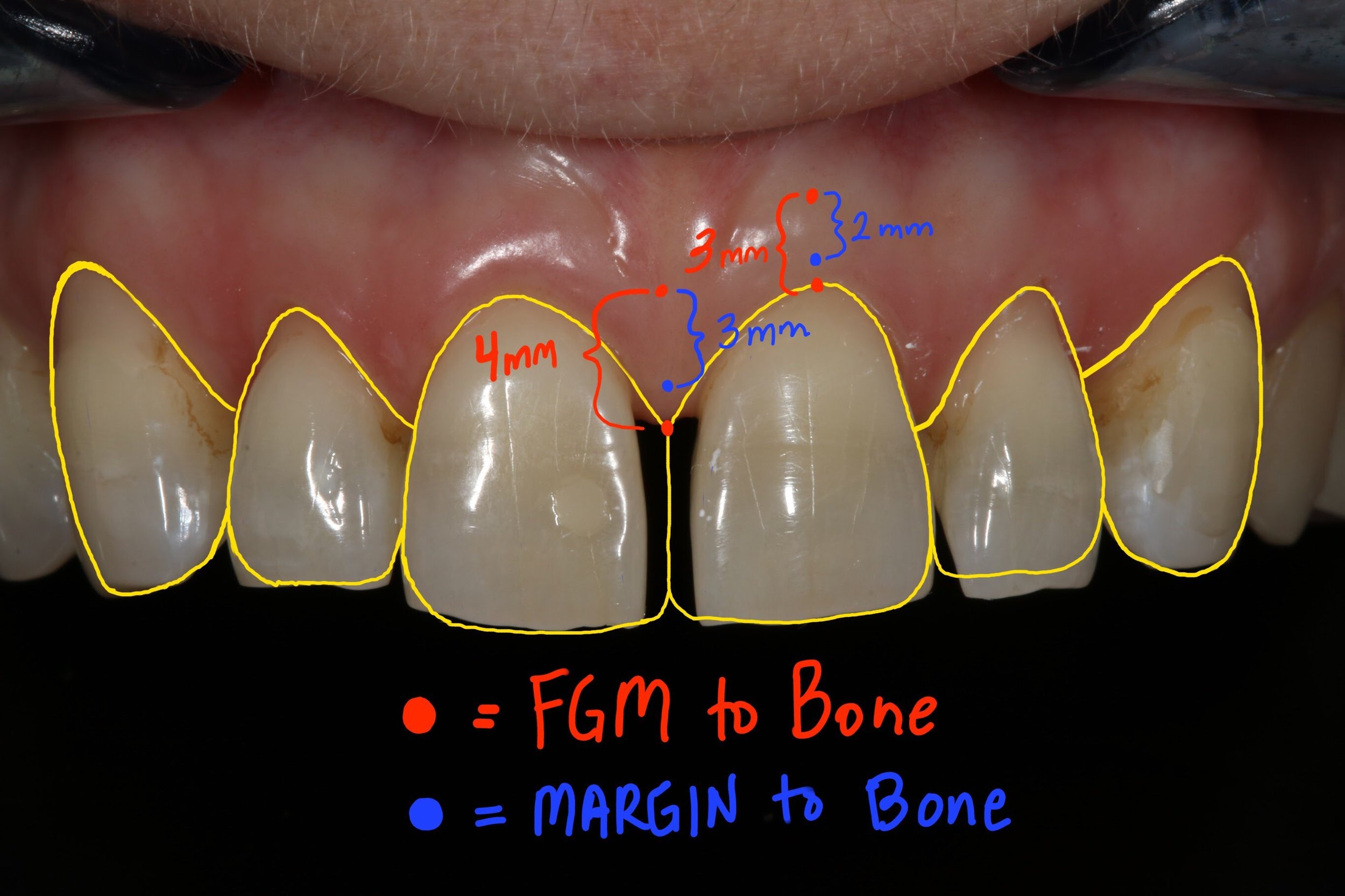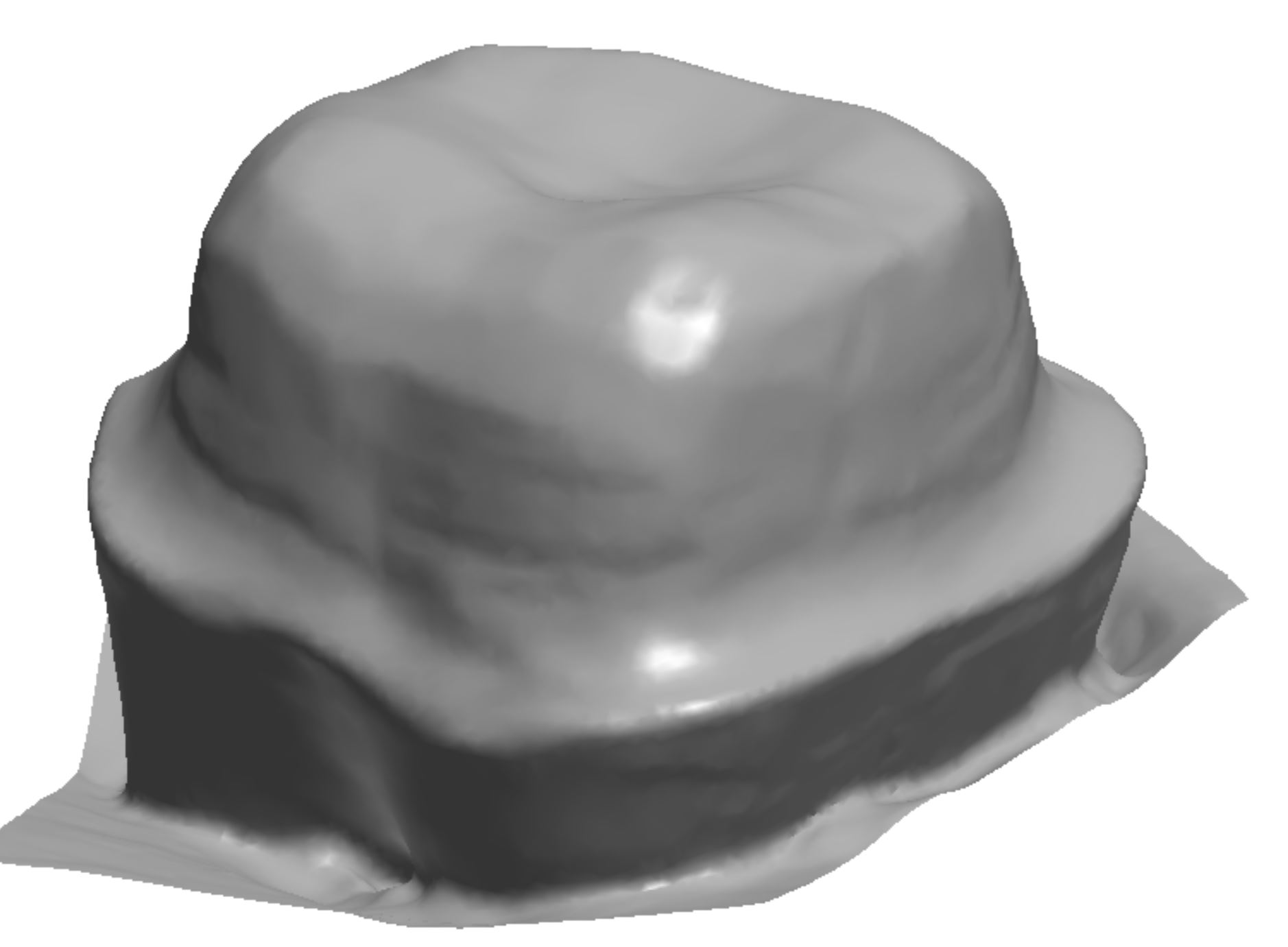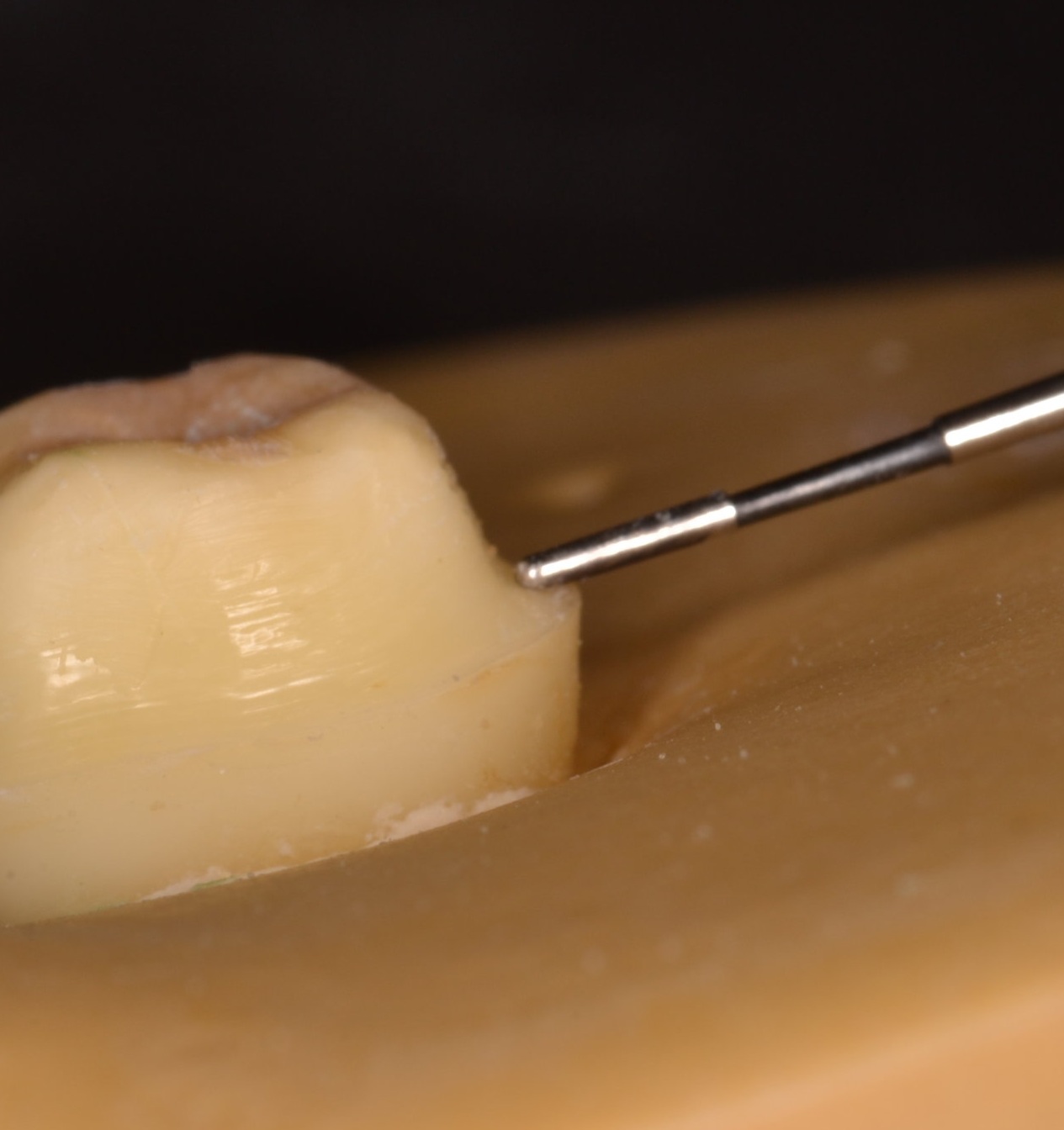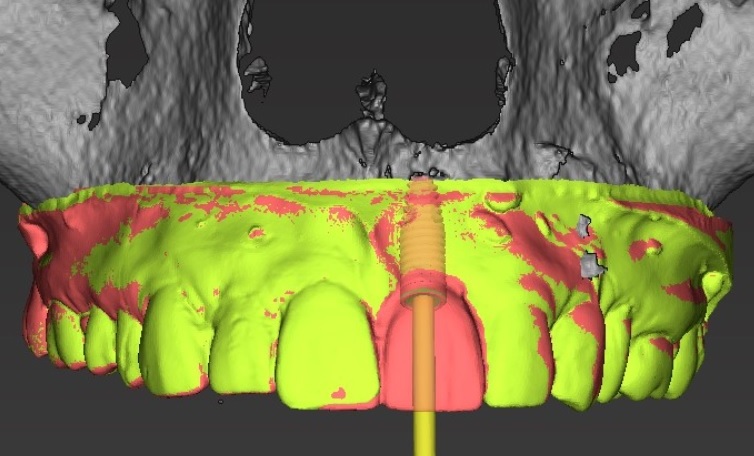
Soft Tissue Management and Laboratory Communication in the Esthetic Zone
Introduction
Early in my career I developed an interest in cosmetic dentistry and digital photography. As I completed and documented more cases, I noticed common issues arising when communicating with the laboratory and delivering final restorations. I frequently struggled to get the laboratory to make the interproximal contacts long enough to adequately close black triangles, and I would try in restorations and see exposed facial margins after temporization, and I lacked confidence when deciding if the tissue would rebound to an acceptable position (figure 1).
Figure 1; A black triangle upon delivery of veneers.
I found that when cases achieved the desirable outcome it was due to luck, and when the outcome was less than desirable it created considerable stress. Individuals have attempted to solve this issue, for example, Willi Geller developed a method referred to as the “Carrot Model” or “Geller Model” in which the individual dies are trimmed and inserted into a model replicating the soft tissue (figure 2a, 2b). [i] The downside to this option is this technique is quite labor intensive for the dental laboratory. At times, technicians have attempted to replicate soft tissue with silicone. The problem with this is often times they replicated tissue that was distorted after retraction.
Figure 2a; Geller model with dies in place
FIgure 2b; In the fabricated Geller master cast, the dies are removed coronally and the soft tissue in the casting is preserved.
Additionally, I would rely on statistical averages and share those approximate values with the laboratory, hoping that would be enough to achieve the ideal result. Despite all the efforts, the results were not as consistent as I had hoped. More recently, I have implemented a protocol to deliver results like that shown in figure 3 predictably.
Figure 3; Before and after closing a diastema with porcelain.
Figure 4; The desired outcome after indirect restorations.
So how does one go from treatment goal to desired final outcome predictably?
In 1961 Gargiulo et al. published research indicating an average biologic width of 2.04 mm, and a sulcus depth of .69 mm [ii]. However, due to human variability, and variation in probings per clinician, we must look at the dentogingival complex as a whole in order to achieve the desired cosmetic result (figure 4). A study of 100 healthy patients found an average distance from facial bone to gingival margin of 3 mm. [iii] Van Der Velden found an average interproximal distance from bone to papilla of 4.3 mm. [iv] The foundation for predictable soft tissue management begins with accurate assessment of these numbers both facially and interproximally at or before preparation. [iii] The following steps should be taken when preparing teeth to be restored in the esthetic zone:
1. Administer local anesthetic.
2. Sound the bone level through the gingival attachment to the osseous crest (with periodontal probe at ~ 45 degree angle).
3. The gingival margin should be 3 mm from bone on the facial and 4 mm from bone interproximally in those patients with a normal crest relationship (figure 5).
4. Prepare the tooth without retraction, margin location should be 2 mm from bone on facial, and 3 mm from bone interproximally. This ensures the margin will not be visible, while not invading the biologic width (figure 5).
5. Instruct the laboratory to make the most apical interproximal contact point 1 mm from margin. This will ensure papilla rebound to fill the black triangle (figure 6).
Figure 5; Gingival and crown margin distance to bone
Figure 6; Distance from gingival margin to preparation margin
Figure 7a; Black triangle closure using the proposed protocol and laboratory instruction for predictable soft tissue results (1:1 magnification view)(Case and photos by Dr. Ryan Yakowicz)
Figure 7b; Black triangle closure using the proposed protocol and laboratory instruction for predictable soft tissue results (3:1 magnification lateral view)(Case and photos by Dr. Ryan Yakowicz)
If we have done our due diligence at or prior to preparation, we know the gingival margin and preparation location in relation to the bone. Despite distortion at the time of insertion, we can say with confidence whether these restorations will achieve harmony and proper esthetics with the tissue as it matures, even if a black triangle or visible margin exists initially upon delivery of the final restorations (figure 7a, 7b).
Dr. Austin Wessell, DDS
Dr. Wessell maintains a private general and cosmetic dental practice on the far west side of Madison, Wisconsin. Having completed hundreds of hours of continuing education, his interests include cosmetic and full mouth rehabilitation, cosmetic bonding, surgical implant placement, and dental photography.
Dr. Wessell is currently a member of the Madison Dental Progress Forum, the Academy of General Dentistry, the American Academy of Cosmetic Dentistry, and the Chicago Dental Society. Additionally, Dr. Wessell participates in Spear Study Club and is an avid student at the prestigious Kois Center in Seattle, Washington.
[i] “The Carrot Model”
Tric O
Spectrum Dialogue, Vol. 9 No. 2, February 2010
[ii] Dimensions and relations of the dentogingival junction in humans.
Gargiulo AW, Wentz FM, Orban B.
J. Periodontol 1961; 32: 261-267
[iii] Altering Gingival Levels: The Restoration Connection Part 1: Biologic Variables
John C. Kois DMD, MSD
Journal of Esthetic Dentistry
Vol. 6, Number 1 1994
[iv] Regeneration of the Interdental Soft Tissues Following Denudation Procedures
van der Velden U.
J Clin Periodontol. 1982 Nov;9(6): 455
eMax Preparation Guidelines for Posterior Teeth
When I graduated from dental school in 2010, I had never done a veneer, or any other all ceramic restoration for that matter. It wasn’t until I started practicing and pursuing more continuing education opportunities that I became aware of all of the great materials modern dentistry has to choose from. These days, I routinely use metal-free all ceramic materials like eMax, Empress, and Zirconia in my practice. With a plethora of dental materials to choose from, dental laboratories and dentists must educate themselves on how best to utilize the latest and greatest dental materials. The focus of this article will be on lithium disilicate, more commonly known by its brand name, eMax (Ivoclar Vivadent). (figure 0, a pre-operative view)
FIgure 0; pre-operative view of a mandibular second molar.
I have found eMax to be an extremely versatile material in my practice. It’s strong, fits well, looks great, is lutable with conventional cements or bondable with adhesive resin cements, and remains color stable over time[i]. I commonly use eMax for single unit indirect restorations (inlays, onlays, crowns, and veneers) in the anterior and posterior. Within the main category of all-ceramic crowns, there are two common subsets, monolithic and layered. My preference is usually to place monolithic eMax restorations in the posterior to maximize the flexural strength (commonly over 400 MPa). This restoration can be milled from a CAD/CAM design or pressed from a wax pattern with some differences in mechanical properties.[ii],[iii] As the tooth to be restored moves closer to the anterior, I tend to favor an eMax coping with a layering porcelain to maximize esthetics. It is important to note that the strength of an indirect restoration will always be limited by the weakest component. For example, a monolithic eMax crown will have a flexural strength of about 260-440 MPa, depending on whether it is milled or pressed[iv]. However, a layered (bi-laminar) eMax crown that utilizes lithium disilicate as a coping that is then layered with a feldspathic porcelain (a flexural strength of about 100 MPa) will only have a flexural strength of 100 MPa, as fracture failure of the layering porcelain, and therefore the restoration, will occur at 100 MPa. Now, techniques like micro-cutback for layering ceramics, and maintaining an incisal shroud in core material help keep the restorations strong in areas that experience high flexural stress.
Preparation design for eMax is straightforward, with some potential pitfalls to be aware of. Preparation design should be very smooth, with no sharp internal (if preparing an inlay or onlay) or external line angles. Occlusal reduction can be variable depending on the type of preparation and can get confusing. Thin eMax veneers, for instance, may only require a 0.3 mm of facial reduction. An occlusal veneer in the posterior that is bonded to enamel may only require 1.0 mm of occlusal reduction. For the purpose of practicality and consistency, consider using 2.0 mm as the recommended value of occlusal reduction for eMax in the application of a single unit posterior indirect restoration (figure 1a). It’s an easy number to remember, and any type of indirect restoration in the posterior segment can be utilized with predictability at this depth. Furthermore, a common preparation bur is the 856L-020 round end taper diamond. It is 2 mm wide, allowing visualization of a proper amount of reduction, as the width of the bur can be used to make 2 mm depth cuts in the occlusal table. It sounds obvious, but the operator should be cognizant that the areas of the occlusal reduction follow the anatomy of the tooth. The prepared occlusal table should be deeper in the central fossa, for example (figure 1b). If this is not accomplished, less restorative material will be present in a part of the tooth that commonly receives centric contact from an opposing cusp, increasing the likelihood of material fracture. The buccal or lingual groove is also an important area to consider adequate reduction, as this part of the crown is meant to allow an occlusal spillway for opposing cusps in eccentric movements.
Figure 1a; 2 mm occlusal table reduction, buccal half of a mandibular second molar from a mesial view
Figure 1b; 2 mm occlusal table reduction, buccal half of a mandibular second molar from a mesial view. The reduction follows the contour of the tooth into the buccal groove
Axial wall reduction is also vital to success. It is imperative that the circumferential axial wall reduction in the coronal third is at least 1.5 mm for an adequate bulk of material. A specific area of the preparation to be acutely aware of is the function cusp bevel, as care needs to be taken to ensure both occlusal and gingival portions “roll” into the bevel. The three planes created by such a bevel should not be well demarcated, and should flow gently into and from one another (figure 2).
Figure 2; The buccal half is prepared to the finish line with a function cusp bevel that is smooth and will not concentrate forces capable of fracturing the all ceramic restoration.
Finish line design should be at minimum a 1 mm wide circumferential heavy chamfer, and is commonly prepared as a shoulder with round internal line angles at the same depth of 1.0 - 1.5 mm (figure 3a, 3b, 3c). When preparing the finish line, special care should be taken to make the finish line smooth while avoid undercuts in the cervical portion of the tooth. Care should also be taken to create a finish line that is in fact round in its internal aspect – a 90-degree shoulder that could be created with a flat end taper diamond should be avoided, as stress will concentrate at the sharp angle that has been incorporated into the preparation design. The margin should probably be more conservative than many operators prepare teeth for all ceramic restorations. The “cowboy hat” margin that approaches 3 mm in width should be avoided in an effort to preserve and conserve natural tooth structure, as a finish line this wide also requires a dramatic increase in the amount of axial wall reduction, ultimately contributing to a greater volume of surgically removed hard tissue. As the margin increases in thickness, it also becomes more difficult to control the smoothness and overall shape of the finish line. Creating unsupported tooth structure by preparing a margin that has a “ski-slope” should be avoided for biologic reasons as well as crown fabrication reasons. The “lip” caused by placing the margin more than halfway beyond the tip of the diamond bur makes crown fabrication difficult, and can present challenges in obtaining an accurate optical scan. Whether the optical scan is done chairside with an intra-oral scanner or at a dental lab to digitize a gypsum model from a conventional impression, the scanner tends to have a hard time picking up the “lip,” compromising accuracy and fit at the margin and potentially creating some hyper-occlusion issues if the restoration does not seat properly. By using the same 856L-020 bur, which is 2 mm wide, half of the bur width will create an adequate 1 mm wide finish line (figure 4). Although eMax offers the operator the ability to adhesively bond the indirect restoration, a tooth preparation with an axial wall height of at least 4 mm and ideal taper of 6 degrees will offer adequate mechanical retention regardless of luting technique.
Figure 3a
Figure 3b
Figure 3c, A digitized version of the tooth preparation for eMax crown, with a smooth finish line that is 1 mm in width
Figure 4
Parameters of tooth preparation can change based on location in the mouth, type of indirect restoration, and mode of cementation. This blog is meant to provide guidelines for successful preparation of teeth for single unit posterior eMax crowns (figure 5, figure 6). Online resources are available to further detail specific preparation recommendations from manufacturers like Ivoclar Vivadent (http://www.ivoclarvivadent.com/en/p/all/products/all-ceramics/ips-emax-dentist/preparation).
Figure 5; The completed tooth preparation.
Figure 6; Clinical photo of monolithic eMax crown preparation of a maxillary first molar.
Remember, dentistry should be FUN! Hopefully this knowledge empowers you to predict your clinical outcomes and decreases your stress, so that the next time you prepare an eMax crown, it’s not a job, it’s FUN!
Ryan
Dr. Ryan J. Yakowicz, DDS, FAGD
Dr. Yakowicz practices in the Greater Madison Area of South Central Wisconsin. Having completed over 775 hours of continuing education, his special interests include functionally cosmetic full mouth rehabilitation, TMD and oral-facial pain, and surgical implant placement and prosthetic restoration.
Dr. Yakowicz is currently the president of the Madison Dental Progress Forum Study Club and the Wisconsin Institute for Advanced Dental Education. He is a fellow of the Academy of General Dentistry, and is a member of the American Academy of Cosmetic Dentistry, and the American Academy of Fixed Prosthodontics. Additionally, Dr. Yakowicz participates in research studies for the National Provider-Based Research Network and is an Ambassador to the National Health Service Corps
[i] Color stability of lithium disilicate ceramics after aging and immersion in common beverages
Palla, Eleni-Sotiria et al.
Journal of Prosthetic Dentistry , Volume 119 , Issue 4 , 632 - 642
[ii] Evaluation of marginal discrepancy of pressable ceramic veneer fabricated using CAD/CAM
system: Additive and subtractive manufacturing.
Kang SY, Lee HN, Kim JH, Kim WC
The Journal of Advanced Prosthodontics [22 Oct 2018, 10(5):347-353]
[iii] "Digitally Oriented Materials": Focus on Lithium Disilicate Ceramics.
Zarone F, Ferrari M, Mangano FG, Leone R, Sorrentino R.
Int J Dent. 2016;2016:9840594.
Anterior Implant Placement and the 3:2 Rule
When I was a younger man, I lost my left maxillary central incisor due to facial trauma. For many years after the initial traumatic injury, the tooth was preserved with root canal treatment, post and core, and a porcelain fused to metal crown. Eventually, the tooth fractured and was non-restorable. The determination was made to remove tooth #9 and immediately place a dental implant. At best, the implant treatment provided was at best an example of successful osseo-integration and at worst a massive cosmetic failure. Although the implant did osseo-integrate and has provided a stable and functional fixture to support a dental restoration for almost 20 years, the implant selection relative to diameter, and position of placement relative to available bone left a lot to be desired, ultimately contributing to a poor cosmetic outcome for the patient (me!)(figure 1a, figure 1b). Luckily, I have a low smile line and am rarely clean-shaven, both qualities that help overcome the positioning errors and potential pre-emptive timing of implant placement[i] (I was only 17 years old when the implant was placed).
Figure 1a
Figure 1b
Advances in dental technology have dramatically changed the way dentistry is being done since my implant was placed almost 20 years ago. Specifically, data acquisition and integration, and how it aides treatment planning for the dental patient, has continued to evolve and expand in ways that improve predictability and outcomes for complex cases and implant dentistry.
For example, the availability of Cone Beam Computed Tomography (CBCT) information coupled with information translated from an intra-oral scan or digitized dental gypsum model into an STL file (Standard Tesselation Language) has become an integral part of treatment planning the safe and effective surgical placement of dental implants. At a minimum, the layers of information contained in a CBCT scan can allow an implant surgeon to evaluate the candidacy of a patient for dental implant treatment based on bone density (given in Hounsfield Units) and bone volume[ii]. Likewise, the information allows the surgeon to select an appropriate implant diameter and length for the intended site that will avoid vital structures such as the mental foramen, mandibular canal, or maxillary sinus. More astutely, this information, when integrated with digital models of the patient’s dentition, can allow the surgeon to envision an implant angulation that will facilitate a good restorative position of the eventual implant supported restoration. By going even one step further, Computer-aided design and Computer-aided Manufacturing (CAD/CAM) can allow a dentist or laboratory technician to create a surgical drilling guide that will enable the surgeon to transfer the digital implant position from the CAD/CAM software to the living patient, thus ensuring surgical placement of a dental implant that avoids vital structures, is adequately encompassed by bone, and is in the best restorative position possible relative to bone volume (figure 2a, figure 2b, figure 2c).
Figure 2a; Planned implant placement relative to bone volume utilizing CBCT and CAD.
Figure 2b; Implant placement proposal relative to desired tooth position with digitized model replacing tooth #9.
Figure 2c; Surgical drilling guide plan in CAD, ready to be 3D printed.
This workflow is especially important when planning the placement of a dental implant in the anterior maxilla, also referred to as the esthetic zone. First of all, thorough evaluation of the patient and implant site is necessary. Not every patient is an exceptional, or even good, candidate for dental implants in the esthetic zone. Some patients may require adjunctive or alternative treatment in cases where bone height and/or volume in the pre-maxilla is deficient or otherwise compromised. Contributory medical history, gingival and osseous phenotype, parafunctional habits, and hygiene practices should not be overlooked. Patients who have lost an anterior tooth secondary to trauma (like me), may present with a socket classification that directs treatment modalities related to the treatment sequence.[iii] Those patients who initially present as poor candidates for implant treatment in the esthetic zone may require ridge augmentation procedures prior to dental implant placement, extending treatment time and cost. Even for a patient that presents with, or who through adjunctive procedures has acquired, an adequate volume and density of bone to accommodate a dental implant, cosmetic outcomes must be considered when placing an implant in the esthetic zone. For example, a patient may have enough bone to place a dental implant, but the placement of the implant into that bone may not facilitate a dental restoration that provides a functionally cosmetic outcome relative to soft tissue architecture or tooth position[iv]. The final result of the implant restoration in terms of esthetic criterion can be especially challenging.
Luckily, a fairly simple guideline exists for the surgeon to adhere to when planning and executing dental implant placement in the esthetic zone. An article by Dr. Lyndon Cooper in a 2008 issue of the Journal of Restorative Dentistry states, “The ideal depth of the implant placement is suggested to be 3 mm apical to the planned gingival zenith. The implant/abutment interface should also reside 2 mm palatal to the zenith to ensure adequate thickness of bone and mucosa to support tissue form. This “3:2 Rule” further suggests to the clinician when bone grafting or soft tissue augmentation should be performed.”[v] The assertion is simple: in the anterior maxilla, especially in the area of the central incisor, the implant platform should be placed 3 mm apical to the proposed gingival zenith and 2 mm palatal to the proposed facial surface of the crown restoration. The rationale for the “3” is scientifically sound as it is a number that has been validated in the literature as the average width of the supra-crestal dento-ginigval complex in humans[vi],[vii](figure 3). As such, the implant restoration must have adequate space for development of supra-crestal fibers associated with the implant restoration if proper gingival health and esthetic gingival display are to be achieved. If the implant is placed too deep (too apical) relative to these parameters, the restoration will likely present with a gingival zenith that is too apically located, and can be challenging to restore. If the implant is not placed deep enough (too coronal), an insult to the formation of biologic width is introduced, and tissue response to the implanted device is compromised (figure 4a, figure 4b). The “2” is practical and is more related to cosmetics and function of the hard tissue aspects of the prosthetic, as it allows an adequate thickness of ceramic material and provides the dental technician space to create internal modifications that develop appropriate dentin shade, enamel shade, and micro-esthetics. This also ensures that the facial plane of the restoration is consistent with the rest of the dental arch, and that the restoration reflects and refracts light adequately relative to its position (a more facial restoration will look bigger and brighter, a more palatal restoration will appear smaller and darker). If the implant is placed too facial, it becomes more difficult for the technician to create a strong restoration that is beautiful, lifelike, and undetectable as a false tooth. If the implant is placed too palatal, occlusal challenges, speech impediments or patient discomfort can come to fruition. If the guidelines are followed, an esthetic restoration with a properly located gingival shroud can be attained (figure 4c, figure 4d).
Figure 3
Figure 4a; Clinical outcome of the implant platform being placed too shallow (too coronal)
Figure 4b; The fixture platform is placed at the level of the adjacent gingival zenith, when it should be 3 mm apical to this landmark
Figure 4 c; Before and after photo of restored dental implant to replace tooth #9 (from Figure 2 plan). Implant surgery performed by Dr. Andrew J. Carmosino, DDS, MS
Figure 4d; Visualization of the fixture platform relative to the proposed gingival margin.
Whether the surgeon is placing an anterior implant in a healed site or immediately at the time of a minimally traumatic tooth extraction (figure 5a, figure 5b, figure 5c), CBCT information integrated with STL files can help plan the implant location in a position to encourage a cosmetically acceptable outcome. If inadequate bone exists to facilitate such placement, ridge augmentation procedures should be considered to achieve a better esthetic result. The beauty of the integrated information is that the surgeon or dentist “quarterbacking” the case with a specialist can examine appropriately and measure accurately the best placement for an anterior implant. Once a digitized model or intra-oral scan of the patient’s dentition is “overlayed” onto a CBCT scan, a digitized patient exists within CAD software, and tooth position can be evaluated relative to bone position. Then, utilizing CAD/CAM technology, a digital replica of a specific type and size of dental implant can be placed into the digital patient and evaluated for length, diameter, and proximity to vital structures. Moreover, specific measurements can be taken to inform the surgeon of the relative distance to other dental structures. If a diagnostic wax-up or other prototype has been completed to inform the digital technician of the proposed gingival zenith and facial surface of a missing maxillary anterior tooth, measurements can be taken to guide implant placement so that the platform of the fixture is in an appropriate position for maximizing esthetic outcomes – 3 mm apical to the proposed gingival zenith, and 2 mm palatal to the proposed facial surface of the restoration.
Figure 5a; preoperative photo
Figure 5b; atraumatic extraction tooth #9
Figure 5c; Immediate implant placement at time of extraction
Intricate technologies have infiltrated the art and science of dentistry, enhancing the ability of human operators to provide high quality dental care for patients. As good as the technology is and will become, it is important to remember that technology is not a replacement for possessing the knowledge and skill necessary to execute procedures soundly and safely.
Remember, dentistry should be FUN! Hopefully this knowledge empowers you to predict your clinical outcomes and decreases your stress, so that the next time you plan to place an anterior implant, it’s not a job, it’s FUN!
Dr. Ryan J. Yakowicz, DDS, FAGD
Dr. Yakowicz graduated from Marquette University School of Dentistry in 2010 and currently practices in the Greater Madison Area of South Central Wisconsin. Having completed over 775 hours of continuing education, his special interests include functionally cosmetic full mouth rehabilitation, TMD and oral-facial pain, and surgical implant placement and prosthetic restoration.
Dr. Yakowicz is currently the president of the Madison Dental Progress Forum Study Club and the Wisconsin Institute for Advanced Dental Education. He is a Fellow of the Academy of General Dentistry, and a member of the American Academy of Cosmetic Dentistry, and the American Academy of Fixed Prosthodontics. Additionally, Dr. Yakowicz participates in research studies for the National Provider-Based Research Network and is an Ambassador to the National Health Service Corps.
Dr. Andrew J. Carmosino, DDS, MS
Dr. Andrew Carmosino graduated from SUNY Buffalo School of Dental Medicine in 2009. He completed a GPR at Brigham and Women’s hospital and practiced as a general dentist in Erie, PA for two years prior to specializing in Periodontics. Dr. Carmosino earned a master’s degree in Oral Sciences and a specialty certificate in Periodontics from the University of Illinois at Chicago College of Dentistry. He is a diplomate of the American Board of Periodontology. His society memberships include the American Academy of Periodontology, American Dental Society, and the Academy of Osseointegration. Dr. Carmosino currently works in a private practice in Madison, WI, which is limited to periodontics and dental implants.
[i] American Journal of Orthodontics and Dentofacial Orthopedics. Volume 131, Number 4, Supplement 1
Determining the cessation of vertical growth of the craniofacial structures to facilitate placement of single-tooth implants
Piotr Fudalej,a Vincent G. Kokich,b and Brian Lerouxc
[ii] Dental Implant Prosthetics, Edition 2 (2015)
Chapter 14
Eslevier Mosby, St. Louis, MO.
[iii] J Calif Dent Assoc. 2005 Nov;33(11):853-63.
Extraction defect assessment, classification, and management.
Caplanis N1, Lozada JL, Kan JY.
[iv] Bonded Porcelain Restorations in the Anterior Dentition: A Biomimetic Approach (2003)
Chapter 2
Quintessence Publishing Co, Chicago, IL
Magne, Pascal. Besler, Urs.
[v] J Esthet Restor Dent. 2008;20(3):195-205.
Objective criteria: guiding and evaluating dental implant esthetics.
[vi] Journal of Periodontology. 1961; July 1.
Dimensions and Relations of the Dentogingival Junction in Humans
Anthony W. Gargiulo D.D.S., M.S., Frank M. Wentz D.D.S., PH.D., Balint Orban M.D., D.D.S.
[vii] Int J Periodontics Restorative Dent. 1994 Apr;14(2):154-65.
The dimensions of the human dentogingival junction.
Vacek JS1, Gher ME, Assad DA, Richardson AC, Giambarresi LI.







































